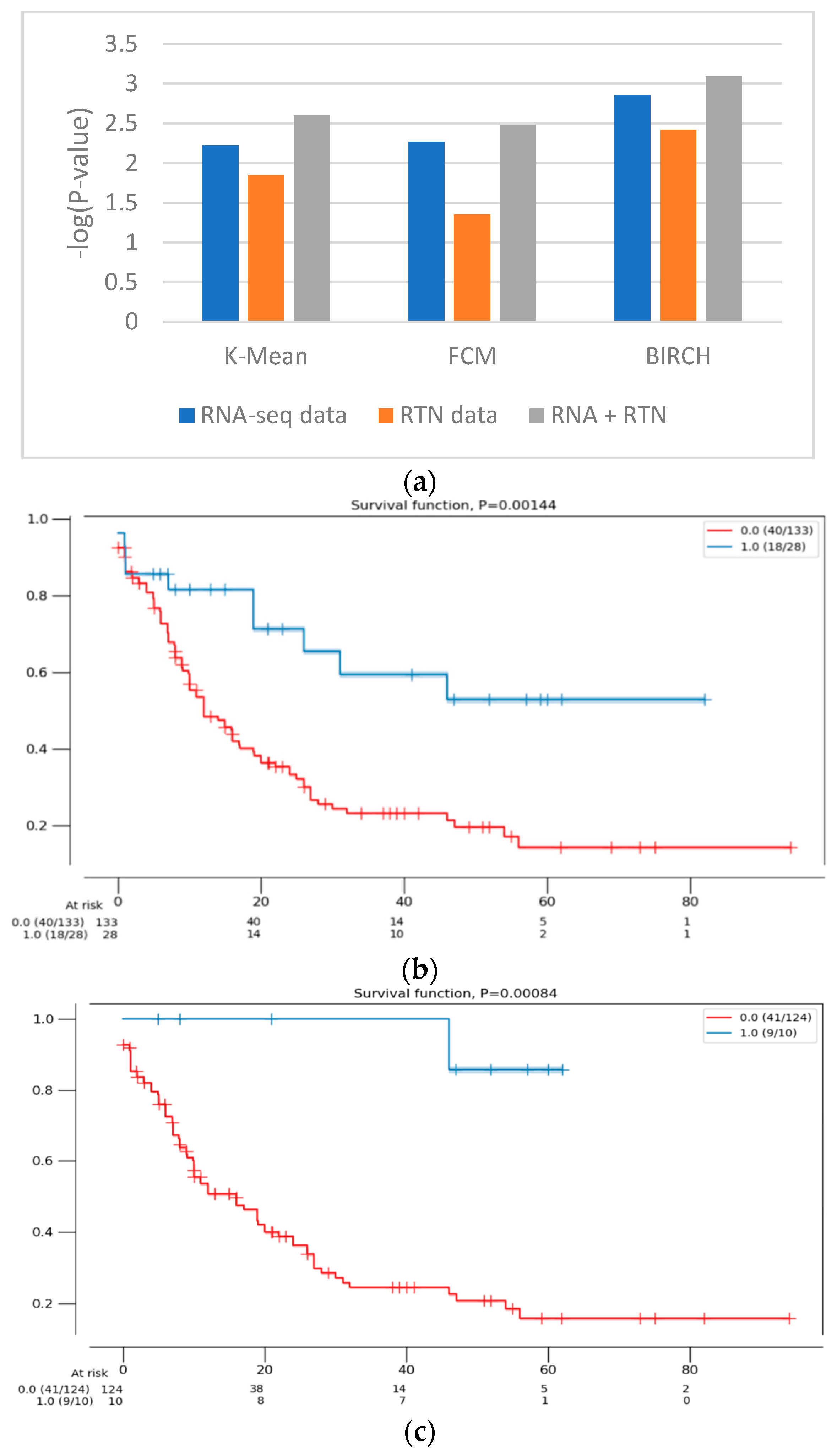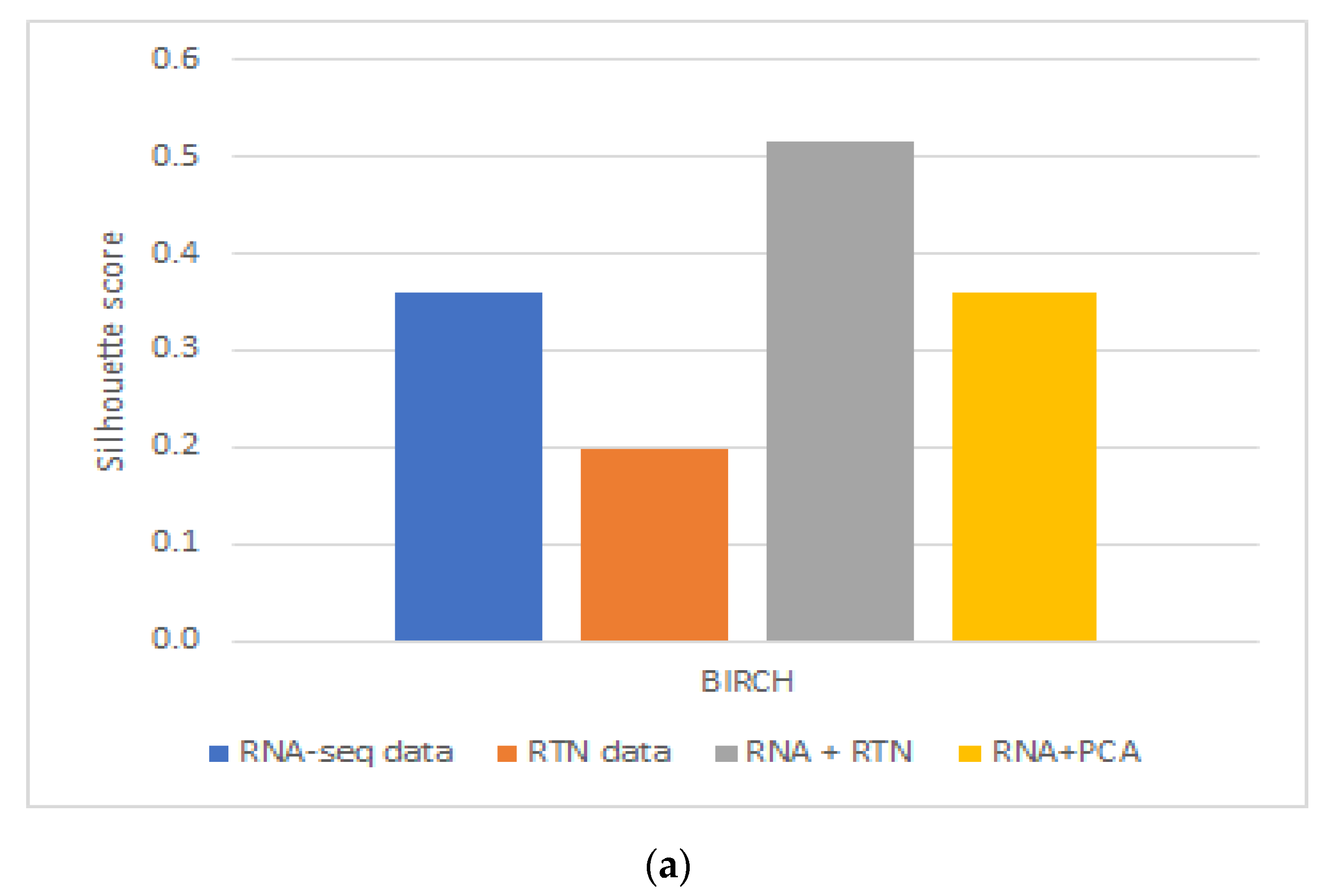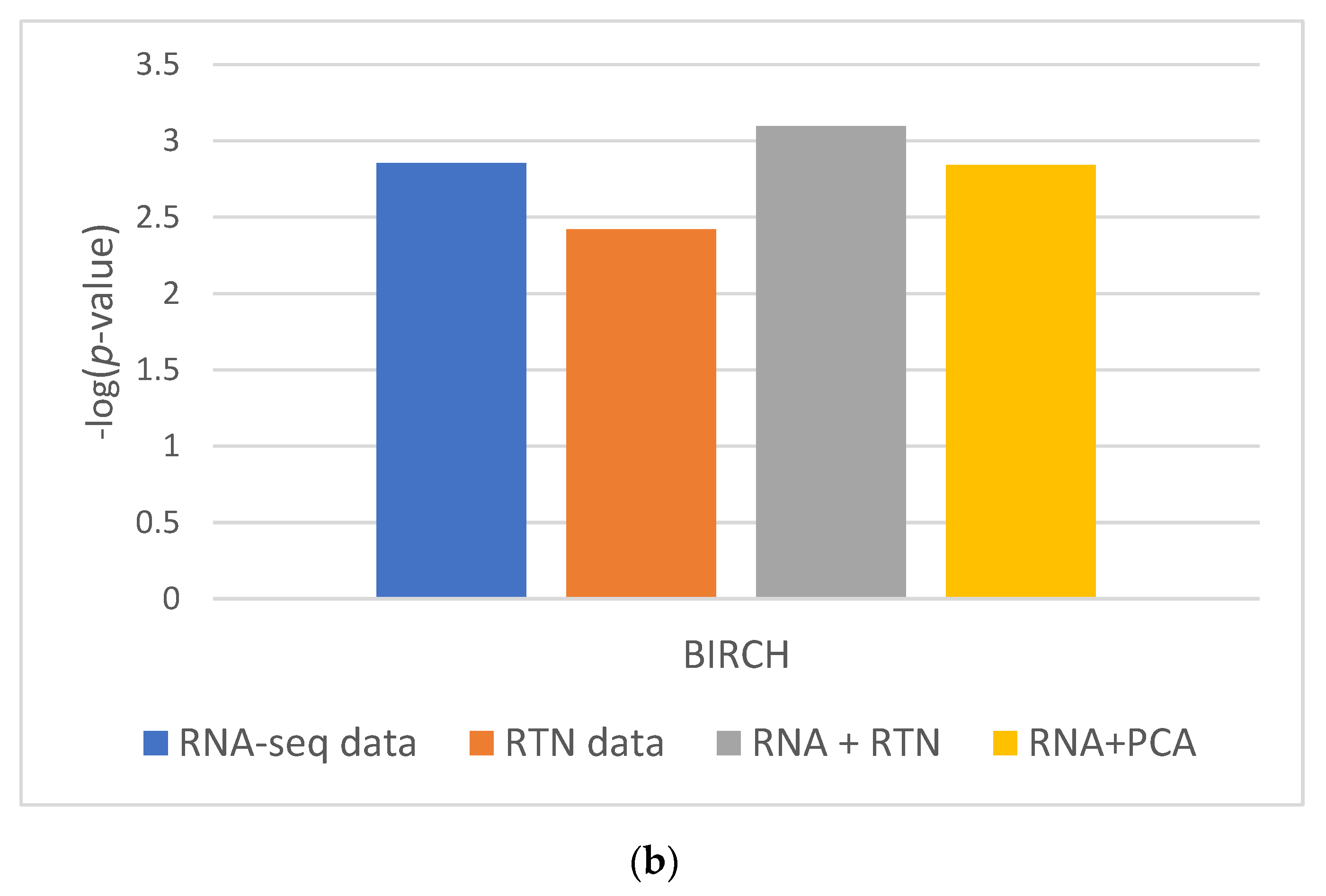Projection of Expression Profiles to Transcription Factor Activity Space Provides Added Information
Abstract
1. Introduction
2. Methods
2.1. RNA-seq Data
2.2. RTN
2.3. Feature Selection
2.4. Clustering and Survival Calculations
3. Results
4. Discussion
5. Conclusions
Supplementary Materials
Author Contributions
Funding
Institutional Review Board Statement
Informed Consent Statement
Data Availability Statement
Conflicts of Interest
References
- Kurakazu, I.; Akasaki, Y.; Hayashida, M.; Tsushima, H.; Goto, N.; Sueishi, T.; Toya, M.; Kuwahara, M.; Okazaki, K.; Duffy, T.; et al. FOXO1 transcription factor regulates chondrogenic differentiation through transforming growth factor β1 signaling. J. Biol. Chem. 2019, 294, 46. [Google Scholar] [CrossRef]
- Tang, Y.; Tan, S.A.; Iqbal, A.; Li, J.; Glover, S.C. STAT3 Genotypic Variant rs744166 and Increased Tyrosine Phosphorylation of STAT3 in IL-23 Responsive Innate Lymphoid Cells during Pathogenesis of Crohn’s Disease. J. Immunol. Res. 2019, 2019, 1–10. [Google Scholar] [CrossRef]
- Turpaev, K.T. Transcription Factor KLF2 and Its Role in the Regulation of Inflammatory Processes. Biochemistry 2020, 85, 54–67. [Google Scholar] [CrossRef]
- Wang, Y.; Hoeppner, L.H.; Angom, R.S.; Wang, E.; Dutta, S.; Doeppler, H.R.; Wang, F.; Shen, T.; Scarisbrick, I.A.; Guha, S.; et al. Protein kinase D up-regulates transcription of VEGF receptor-2 in endothelial cells by suppressing nuclear localization of the transcription factor AP2β. J. Biol. Chem. 2019, 294, 43. [Google Scholar] [CrossRef] [PubMed]
- Dexter, D.T.; Holley, A.E.; Flitter, W.D.; Slater, T.F.; Wells, F.R.; Daniel, S.E.; Lees, A.J.; Jenner, P.; Marsden, C.D. Increased levels of lipid hydroperoxides in the parkinsonian substantia nigra: An HPLC and ESR study. Mov. Disord. 1994, 9, 92–97. [Google Scholar] [CrossRef] [PubMed]
- Fletcher, M.N.; Castro, M.A.; Wang, X.; de Santiago, I.; O’Reilly, M.; Chin, S.-F.; Rueda, O.M.; Caldas, C.; Ponder, B.A.J.; Markowetz, F.; et al. Master regulators of FGFR2 signalling and breast cancer risk. Nat. Commun. 2013, 4, 2464. [Google Scholar] [CrossRef] [PubMed]
- Castro, M.A.; de Santiago, I.; Campbell, T.M.; Vaughn, C.; Hickey, T.E.; Ross, E.D.; Tilley, W.; Markowetz, F.; Ponder, B.A.; Meyer, K.B. Regulators of genetic risk of breast cancer identified by integrative network analysis. Nat. Genet. 2015, 48, 12–21. [Google Scholar] [CrossRef] [PubMed]
- Abramson, N.; Melton, B. Leukocytosis: Basics of clinical assessment. Am. Fam. Physician. 2000, 62, 9. [Google Scholar]
- Bennett, J.M.; Catovsky, D.; Daniel, M.T.; Flandrin, G.; Galton, D.A.G.; Gralnick, H.R.; Sultan, C. Proposed Revised Criteria for the Classification of Acute Myeloid Leukemia. Ann. Intern. Med. 1985, 103, 4. [Google Scholar] [CrossRef]
- Vardiman, J.W. The World Health Organization (WHO) classification of tumors of the hematopoietic and lymphoid tissues: An overview with emphasis on the myeloid neoplasms. Chem. Biol. Interact. 2010, 184, 16–20. [Google Scholar] [CrossRef] [PubMed]
- Rashidi, A.; Weisdorf, D.J.; Bejanyan, N. Treatment of relapsed/refractory acute myeloid leukaemia in adults. Br. J. Haematol. 2018, 181, 27–37. [Google Scholar] [CrossRef] [PubMed]
- Erba, H.P. Finding the optimal combination therapy for the treatment of newly diagnosed AML in older patients unfit for intensive therapy. Leuk. Res. 2015, 39, 183–191. [Google Scholar] [CrossRef] [PubMed]
- Podoltsev, N.A.; Stahl, M.; Zeidan, A.M.; Gore, S.D. Selecting initial treatment of acute myeloid leukaemia in older adults. Blood Rev. 2017, 31, 43–62. [Google Scholar] [CrossRef] [PubMed]
- Rowe, J.M. Progress and predictions: AML in 2018. Best Pract. Res. Clin. Haematol. 2018, 31, 4. [Google Scholar] [CrossRef]
- Wei, A.H.; Tiong, I.S. Midostaurin, enasidenib, CPX-351, gemtuzumab ozogamicin, and venetoclax bring new hope to AML. Blood 2017, 130, 23. [Google Scholar] [CrossRef]
- Coombs, C.C.; Tallman, M.S.; Levine, R.L. Molecular therapy for acute myeloid leukaemia. Nat. Rev. Clin. Oncol. 2016, 13, 5. [Google Scholar] [CrossRef]
- Shallis, R.M.; Wang, R.; Davidoff, A.; Ma, X.; Zeidan, A.M. Epidemiology of acute myeloid leukemia: Recent progress and enduring challenges. Blood Rev. 2019, 36, 70–87. [Google Scholar] [CrossRef]
- Lallemand-Breitenbach, V.; Zhu, J.; Chen, Z.; de Thé, H. Curing APL through PML/RARA degradation by As2O3. Trends Mol. Med. 2012, 18, 36–42. [Google Scholar] [CrossRef] [PubMed]
- Alpermann, T.; Schnittger, S.; Eder, C.; Dicker, F.; Meggendorfer, M.; Kern, W.; Schmid, C.; Aul, C.; Staib, P.; Wendtner, C.-M.; et al. Molecular subtypes of NPM1 mutations have different clinical profiles, specific patterns of accompanying molecular mutations and varying outcomes in intermediate risk acute myeloid leukemia. Haematologica 2016, 101, e55–e58. [Google Scholar] [CrossRef]
- Lee, S.-I.; Celik, S.; Logsdon, B.A.; Lundberg, S.M.; Martins, T.J.; Oehler, V.G.; Estey, E.H.; Miller, C.P.; Chien, S.; Dai, J.; et al. A machine learning approach to integrate big data for precision medicine in acute myeloid leukemia. Nat. Commun. 2018, 9, 1–13. [Google Scholar] [CrossRef] [PubMed]
- Voigt, P.; Reinberg, D. Genomic and Epigenomic Landscapes of Adult De Novo Acute Myeloid Leukemia. The Cancer Genome Atlas Research Network. New Engl. J. Med. 2013, 369, 1. [Google Scholar] [CrossRef][Green Version]
- Tyner, J.W.; Tognon, C.E.; Bottomly, D.; Wilmot, B.; Kurtz, S.E.; Savage, S.L.; Long, N.; Schultz, A.R.; Traer, E.; Abel, M.; et al. Functional genomic landscape of acute myeloid leukaemia. Nature 2018, 562, 526–531. [Google Scholar] [CrossRef]
- Github – AutoViML/ featurewiz. Available online: https://github.com/AutoViML/featurewiz (accessed on 4 September 2022).
- Purnima, B.; Arvind, K. EBK-Means: A Clustering Technique based on Elbow Method and K-Means in WSN. Int. J. Comput. Appl. 2014, 105, 9. [Google Scholar]
- Pelleg, D.; Moore, A. Accelerating exact k-means algorithms with geometric reasoning. In Proceedings of the Fifth ACM SIGKDD International Conference on Knowledge Discovery and Data Mining, San Diego, CA, USA, 15–18 August 1999; Carnegie Melon University: Pittsburgh, PA, USA, 1999; pp. 277–281. [Google Scholar] [CrossRef]
- Fan, J.L.; Zhen, W.Z.; Xie, W.X. Suppressed fuzzy c-means clustering algorithm. Pattern Recognit. Lett. 2003, 24, 9–10. [Google Scholar] [CrossRef]
- Zhang, T.; Ramakrishnan, R.; Livny, M. BIRCH: An Efficient Data Clustering Method for Very Large Databases. ACM SIGMOD Rec. 1996, 25, 2. [Google Scholar] [CrossRef]
- Lambert, S.A.; Jolma, A.; Campitelli, L.F.; Das, P.K.; Yin, Y.; Albu, M.; Chen, X.; Taipale, J.; Hughes, T.R.; Weirauch, M.T. The Human Transcription Factors. Cell 2018, 172, 4. [Google Scholar] [CrossRef] [PubMed]




| Characteristic | TCGA | OHSU |
|---|---|---|
| Age at study entry—yr | 55.3±16.1 | 57.0±18.1 |
| N (with mRNA) | ||
| Total | 173 | 451 |
| With survival data | 161 | 411 |
| With survival data and RTN | 134 | 411 |
| Race or ethnic group—no. (%) | ||
| White | 156 (90) | 340 (83) |
| Black | 13 (8) | 14 (3) |
| Other | 4 (2) | 57 (14) |
| Male sex—no. (%) | 93 (54) | 233 (57) |
| AML FAB subtype—no. | ||
| Undifferentiated AML—M0 | 16 | 6 |
| AML with minimal maturation—M1 | 42 | 8 |
| AML with maturation—M2 | 39 | 12 |
| Acute promyelocytic leukemia (APL)—M3 | 16 | 10 |
| Acute myelomonocytic leukemia—M4 | 35 | 26 |
| Acute monocytic leukemia—M5 | 18 | 34 |
| Acute erythroid leukemia—M6 | 2 | - |
| Acute megakaryoblastic leukemia—M7 | 3 | 2 |
| Not Classified | 2 | 310 |
| RNA | RNA + RTN | |||
|---|---|---|---|---|
| FAB | Group 0 | Group 1 | Group 0 | Group 1 |
| M0 | 16 | - | 15 | - |
| M1 | 39 | 3 | 35 | - |
| M2 | 31 | 8 | 36 | - |
| M3 | - | 16 | 5 | 10 |
| M4 | 34 | 1 | 28 | - |
| M5 | 18 | - | 12 | - |
| M6 | 2 | - | 2 | - |
| M7 | 3 | - | 1 | - |
| Not Classified | 2 | - | 1 | - |
Publisher’s Note: MDPI stays neutral with regard to jurisdictional claims in published maps and institutional affiliations. |
© 2022 by the authors. Licensee MDPI, Basel, Switzerland. This article is an open access article distributed under the terms and conditions of the Creative Commons Attribution (CC BY) license (https://creativecommons.org/licenses/by/4.0/).
Share and Cite
Bornshten, R.; Danilenko, M.; Rubin, E. Projection of Expression Profiles to Transcription Factor Activity Space Provides Added Information. Genes 2022, 13, 1819. https://doi.org/10.3390/genes13101819
Bornshten R, Danilenko M, Rubin E. Projection of Expression Profiles to Transcription Factor Activity Space Provides Added Information. Genes. 2022; 13(10):1819. https://doi.org/10.3390/genes13101819
Chicago/Turabian StyleBornshten, Rut, Michael Danilenko, and Eitan Rubin. 2022. "Projection of Expression Profiles to Transcription Factor Activity Space Provides Added Information" Genes 13, no. 10: 1819. https://doi.org/10.3390/genes13101819
APA StyleBornshten, R., Danilenko, M., & Rubin, E. (2022). Projection of Expression Profiles to Transcription Factor Activity Space Provides Added Information. Genes, 13(10), 1819. https://doi.org/10.3390/genes13101819







